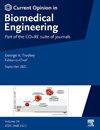Recent advancements and applications of physics-informed machine learning in biomedical research
IF 4.2
3区 工程技术
Q2 ENGINEERING, BIOMEDICAL
引用次数: 0
Abstract
Physics-informed machine learning (PIML) has emerged as a promising approach to modeling complex biomedical systems by integrating underlying biophysical laws with data-driven methods. Neural networks, particularly deep networks, are powerful data-driven function approximators that provide a flexible, scalable, and efficient framework for PIML, enabling the development of models with improved accuracy, interpretability, and robustness. This review examines recent advancements and applications of PIML in key biomedical domains where neural networks have been employed. We discuss core PIML techniques (i.e. physics-informed neural networks, constitutive artificial neural networks, and neural ordinary differential equations) for embedding physics into ML models and their applications in cardiology, oncology, radiology, and endocrinology, among other fields. By synthesizing recent progress and emerging applications from the scientific literature, we aim to highlight the potential of PIML in advancing both fundamental and translational research in biomedical engineering.
基于物理的机器学习在生物医学研究中的最新进展和应用
基于物理的机器学习(PIML)通过将潜在的生物物理定律与数据驱动的方法相结合,已经成为一种有前途的复杂生物医学系统建模方法。神经网络,特别是深度网络,是强大的数据驱动函数逼近器,为PIML提供了灵活、可扩展和高效的框架,使模型的开发具有更高的准确性、可解释性和鲁棒性。本文综述了PIML在神经网络应用的关键生物医学领域的最新进展和应用。我们讨论了将物理嵌入到ML模型中的核心PIML技术(即物理信息神经网络,本构人工神经网络和神经常微分方程)及其在心脏病学,肿瘤学,放射学和内分泌学等领域的应用。通过综合科学文献的最新进展和新兴应用,我们的目标是突出PIML在推进生物医学工程基础研究和转化研究方面的潜力。
本文章由计算机程序翻译,如有差异,请以英文原文为准。
求助全文
约1分钟内获得全文
求助全文
来源期刊

Current Opinion in Biomedical Engineering
Medicine-Medicine (miscellaneous)
CiteScore
8.60
自引率
2.60%
发文量
59
 求助内容:
求助内容: 应助结果提醒方式:
应助结果提醒方式:


